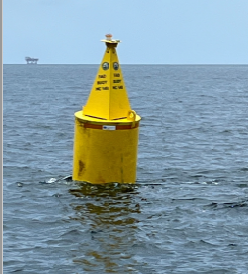
Artificial Reefs
Artificial reefs are manmade objects purposefully placed on the sea floor. Artificial reefs can be created from materials such as cleaned vessels and recycled concrete. These materials are meant to increase the surfaces suitable for encrusting organisms, such as oysters or corals, to attach and grow. The added material also provides refuge to animals that may be vulnerable to predators. Artificial reefs enhance fishing for fishermen and scenery for recreational divers.
The Louisiana Artificial Reef Program was established in 1986 to take advantage of the important habitat offshore oil and gas platforms, slated to be removed from the Gulf of America, provide to many of Louisiana's coastal fishes. When these platforms were decommissioned and removed, this habitat was being lost. Through the Louisiana Artificial Reef Program, oil and gas companies donate decommissioned platforms to LDWF. Companies can also donate half of the savings they realize by reefing rather than bringing the platform to shore to the Artificial Reef Trust Fund. These funds go toward managing, enhancing, and monitoring Louisiana’s inshore, nearshore, offshore, and deepwater artificial reef sites.

LDWF Deploys Fish Attracting Device (FAD) Buoy in Gulf of America

The Louisiana Wildlife and Fisheries Artificial Reef Program has deployed a FAD buoy in LDWF’s Mississippi Canyon 148 Reef. The MC-148 Reef is located approximately 30 nautical miles south-southeast of Venice in 451 feet of water. The buoy is at coordinates Lat 28⁰ 47.646’ Lon 89⁰ 10.527’ and is visible above the water.
This buoy can be expected to attract pelagic species like tuna and wahoo and provide fishing opportunities for anglers who favor those fish.
To view a map of the location of the FAD or a an illustration of this FAD, use these links.
Inshore Artificial Reefs
Inshore artificial reefs are developed in Louisiana state waters between the Louisiana Intracoastal Waterway and the Louisiana coastline and within Lake Pontchartrain. Many inshore areas are relatively shallow so these reefs must be carefully sited and built with a lower profile than offshore artificial reefs. Inshore reefs are created out of several different types of material, including limestone, recycled crushed concrete, and prefabricated material such as reef balls (perforated concrete domes). Inshore reefs are most frequently used by Louisiana fishermen as they’re closer to shore. There are currently 33 inshore reefs dispersed among Louisiana’s coastal basins, including several in Lake Pontchartrain and at Independence Island, a few miles north of Grand Isle.
Nearshore Artificial Reefs
Nearshore artificial reefs are developed in either state or federal waters between the coastline of Louisiana and the 100-foot depth contour. This zone is where the majority of oil and gas platforms slated for removal are currently located. Reefing platforms located close to the coast does not offer much financial incentive for oil and gas companies because it is less expensive to bring the platform back to shore than it is to reef it. The Louisiana Artificial Reef Program developed the Nearshore Artificial Reef Plan to establish partnerships with various user groups to take advantage of the opportunities offered in these shallower waters.
Building artificial reefs in shallower waters requires special considerations to limit navigational hazards. The program seeks to keep the base of the oil and gas platform as well as rock piles and other unique profile features when possible to preserve as much habitat as practicable. Other materials including limestone and recycled concrete are then added to enhance the artificial reef structure.
Like inshore reefs, nearshore reefs are more accessible to anglers than offshore and deepwater reefs. Currently, there are eighteen nearshore artificial reef areas.
Offshore and Deepwater Artificial Reefs
When the Louisiana Artificial Reef Program was first established, all reef sites were located solely in offshore federal waters between the 100-foot contour and the U.S. Exclusive Economic Zone (EEZ) boundary (200 nautical miles from shore). Areas compatible with offshore artificial reef development are generally found between 30 and 70 miles off Louisiana’s gently sloping continental shelf, making them accessible to anglers with offshore vessels.
The program has designated nine offshore artificial reef planning areas where approved reef materials can be towed and added to a larger reef complex. This helps minimize conflicts with other users groups. These areas encompass over 19,000 acres across Louisiana’s coast and include: West Cameron, East Cameron, South Marsh Island 76, South Marsh Island 146, Eugene Island, South Timbalier, West Delta, Main Pass, and Ship Shoal. The program also evaluates special artificial reefs on a case-by-case basis, especially in areas of high interest or favorite fishing spots.
The Louisiana Artificial Reef Program has most recently expanded to developing deepwater artificial reefs, offshore reefs in waters more than 400 feet deep. This expansion is a product of the oil and gas industry moving into deeper waters further from the coast. The long distance from shore results in higher costs for removing decommissioned oil and gas platforms, thus more incentive for oil and gas companies to reef these structures instead.
Today, there are 80 deepwater and offshore reefs comprised of more than 400 structures. In addition, the program has reefed 40 armored personnel carriers, 8 rig legs, 1 jack-up barge, and 1 tugboat in offshore areas.
